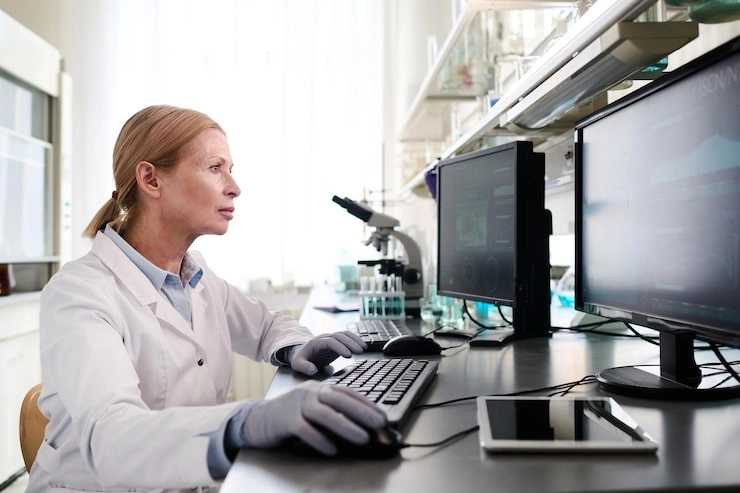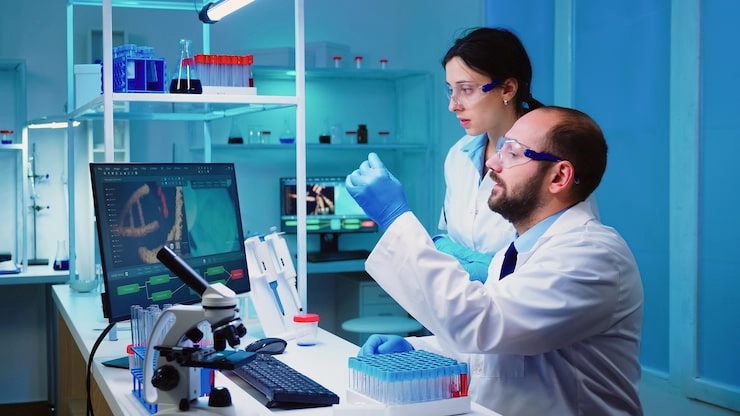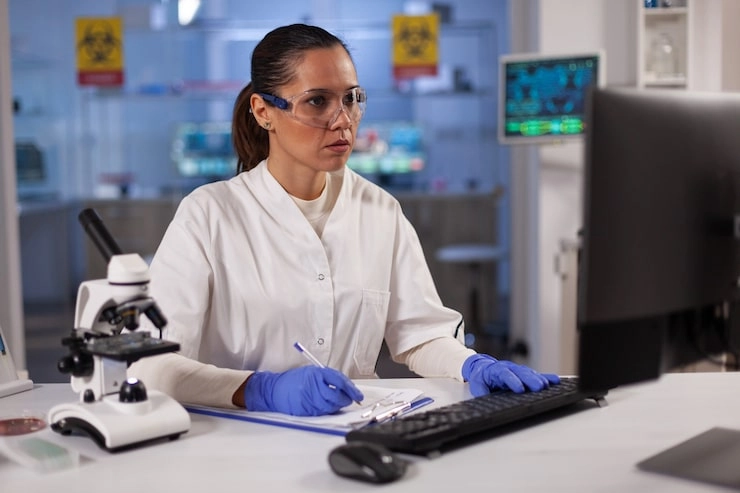
Gas chromatography is a technique of separating components from a raw substance by means of a gaseous mobile phase. This analytical technique has become very popular in the separation, identification, and measurement of volatile and semi-volatile compounds in complicated mixtures. The base operation involves heating the sample to a vapor, carrying it through a column via an inert gas, which aids the separation based on specific physicochemical properties. GC has become of essence in many areas that range from environmental monitoring to pharmaceutical quality assurance due to the effectiveness, sensitivity, and reliability it provides.
Principles of Gas Chromatography Separation
Gas chromatography refers to various analytical separation methods applied to monitor volatile substances in the gaseous state. In gas chromatography, the components of a sample are first dissolved in some solvent. They are then vaporized. This is a separation of analytes accomplished by spreading the sample between two phases: a stationary phase and a mobile phase. The mobile phase, normally an inert gas such as helium or nitrogen, pushes the vaporized sample through a column. The column is internally coated with some liquid or solid stationary phase. Since compounds interact with this stationary phase differently, they elute at different retention times.
Key Components of a Gas Chromatography System
A gas chromatograph has several key parts:
- Carrier gas: This is typically helium, nitrogen, or hydrogen, and it serves as the mobile phase.
- Injector: This part vaporizes the sample. Then, it introduces it into the column.
- Column: It can be either packed or capillary. What’s more, it separates compounds based on their chemical traits.
- كاشف: It is used to measure the concentration of compounds as they leave the column.
The analytical parts of the gas chromatograph are kept inside an oven where the temperature is carefully controlled.
Mechanisms Behind the Separation of Chemicals in GC
The effectiveness of chemical separation in gas chromatography is directed by different natural properties of the analytes and the conditions of the instrument.
Role of Volatility in Separation Efficiency
Compounds with lower boiling points are more volatile. Therefore, they elute faster. As the gas sample travels through the column, components with lower boiling points pass through more quickly than those with higher boiling points. This idea allows for a time-based separation where each compound shows up as its own peak on the chromatogram.
Influence of Polarity and Stationary Phase Interactions
The interaction of the polarity of a compound with the chemistry of the stationary phase greatly affects the retention time. Polar compounds interact much more strongly with polar stationary phases, increasing retention time. Thus, selection of a stationary phase with polarity similar to the analyte will result in better resolution and selectivity.
Temperature Programming and Its Impact on Separation
Temperature control is necessary for reproducible separations. Since a gas chromatograph’s columns and detector are housed in the same oven, instrument performance is directly related to its temperature stability; the temperature, therefore, ordinarily is maintained constant to within ±0.5 °F (±0.3 °C). When the sample contains components with a large range of boiling points, temperature programming-in which the oven temperature is increased at a controlled rate-provides better separation of the peaks and requires less analysis time.
Types of Columns Used in Gas Chromatography
Column design really affects GC performance. So, it should be chosen based on the goals of the analysis.
Packed Columns vs. Capillary Columns
Packed columns are full of an inert solid support that is coated in a stationary phase. They are good for larger sample volumes but offer less sharp resolution. In contrast:
Capillary columns (also called open tubular columns) have very small inner diameters. Their insides are coated with a stationary phase. This provides higher efficiency and creates much sharper peaks. In a capillary column, a thin layer of the stationary phase is applied directly to the inner walls of the tubing.
Choosing the Right Column for Your Application
Deciding between these types depends on things like the complexity of the sample, how much resolution you need, how fast the analysis must be, and the equipment you have. For trace analysis that needs very high resolution, capillary columns are almost always the better choice.
Factors Affecting Chemical Separation in GC Analysis
To get the best chemical separation, a few operational settings must be controlled with great care.
Carrier Gas Flow Rate Considerations
The speed of the carrier gas affects both the analysis time and the resolution. It’s a balancing act. A higher flow rate makes things faster but might cause peaks to overlap. On the other hand, a flow rate that is too slow can make the peaks wider. Thus, the ideal flow rate finds a good balance between speed and the quality of the separation.
Sample Injection Techniques and Their Effects on Results
Modern GC systems have both split and splitless injection modes:
- Split injection keeps the column from getting overloaded. It does this by only letting in a part of the sample.
- Splitless injection introduces the whole sample. This is for detecting substances at very low levels.
- Commercial gas chromatographs often let you use both split and splitless injections, which is useful when you switch between packed and capillary columns.
Column Length, Diameter, and Film Thickness Parameters
Longer columns give you better separation. However, they make the run time longer. Narrower internal diameters improve efficiency but need more pressure to work. Finally, thicker film coatings increase the retention time for volatile analytes, which helps improve peak resolution.
Detection Methods Following Chemical Separation
Once compounds are separated by their retention time, they need to be accurately detected. They also need to be quantified with the right detectors.
Common Detectors Used in GC Systems
Several detectors are very common in GC instruments:
- Flame Ionization Detector (FID)
The FID is usually the most suitable choice because of its great sensitivity and resolution. It is also good because it can spot very small molecules. It’s particularly useful for hydrocarbon analysis due to its wide dynamic range. - كاشف التوصيل الحراري (TCD)
A TCD notices changes in thermal conductivity between the carrier gas and the analyte gases. It can detect anything but is not as sensitive as an FID. - Electron Capture Detector (ECD)
The ECD is extremely sensitive to compounds containing halogens. It is perfect for environmental monitoring that involves things like pesticides or refrigerants.
Applications of Gas Chromatography Across Industries
Because it is so flexible, gas chromatography has become essential in many different fields.
Environmental Monitoring and Pollution Control
You can analyze air samples using GC. It is used a lot to find VOCs (volatile organic compounds) in air, water, and soil. Besides that, regulatory agencies use GC to check on industrial emissions and make sure they follow environmental rules.
Pharmaceutical Quality Control
Gas chromatography helps keep drugs safe. It does this by testing the purity of active pharmaceutical ingredients (APIs). It also identifies any leftover solvents after synthesis.
Food Safety Testing
GC can spot pesticide residues in crops. It can also detect flavoring agents or contaminants in food. These checks help make sure that foods meet health standards.
PERSEE: A Trusted Manufacturer of Analytical Instruments
برسي offers advanced solutions for chemical analysis. Their G5GC model provides high-performance separation that is made for complex tasks, while the M7 series puts gas chromatography into multi-functional platforms. These are great for labs that need flexibility but can’t afford to lose precision.

Commitment to Innovation, Quality, and Global Support
PERSEE focuses on strong engineering. They also prioritize easy-to-use interfaces and worldwide technical help. Their global distribution network makes it easy to get advanced GC systems in academic, industrial, and research settings all over the world.
Summary of Key Concepts in Gas Chromatographic Separation
Chemical separation in gas chromatography really comes down to a few things. These are differences in volatility, polarity interactions, the choice of column, getting the flow rate right, and temperature control. Picking the correct detector ensures you can accurately measure amounts across all kinds of different sample types.
Importance of Method Optimization
Developing a method requires the careful adjustment of the injection technique, carrier gas choice, temperature programming, and detector compatibility. This is all done to get dependable and repeatable results in every single application.
FAQs:
Q1: Can gas chromatography be used to separate nonvolatile compounds?
A1: No. Gas chromatography is only for volatile or semi-volatile compounds that can turn into a vapor without breaking down; nonvolatile substances need different methods, such as liquid chromatography.
Q2: How do I choose between FID and TCD detectors?
A2: FID is better for detecting hydrocarbons because it’s so sensitive. TCD is more of a general-purpose detector but not as sensitive. So, it’s a good choice when you are detecting inorganic gases or when a flame-based detector is not an option.
Q3: Why do some peaks overlap even after adjusting temperature?
A3: Overlapping peaks can happen if the column choice is poor or if the resolution isn’t good enough; trying a different stationary phase or fine-tuning the flow rate can help improve the separation performance.
Q4: Is gas chromatography suitable for real-time air quality monitoring?
A4: Yes. A lot of air quality control units use GC together with FID or ECD detectors. They do this to monitor VOC levels in real-time because of their high sensitivity and precision.
Q5: What types of samples can PERSEE’s GC instruments analyze?
A5: PERSEE’s GC systems are made for a wide range of uses. These include pharmaceuticals, environmental samples, petrochemicals, food safety testing, and academic research, all thanks to their customizable setups.







